In Denver, the demand for landscape rock is soaring as homeowners and landscapers seek a sustainable and visually appealing alternative to traditional turf and mulch.
The rise in popularity is attributed to its low water usage, durability, and an ability to add a refined aesthetic touch to any outdoor space. With Denver’s semi-arid climate, landscape rocks offer an optimal solution that conserves water while resisting the test of time.
This article explains the various types of landscape rock Denver available, dives into a detailed cost breakdown, and outlines local delivery options, including specialized services provided by Mile High Lifescape.
Benefits of Using Landscape Rock in Denver Landscapes
Landscape rock stands as an ideal solution for Colorado’s challenging climate conditions, offering practical advantages that extend well beyond mere aesthetics.
Denver homeowners choose landscape rock for these key benefits:
- Drought-Tolerant: A water-saving alternative that suits Denver’s climate.
- Low Maintenance: Durable materials that require minimal upkeep.
- Prevents Erosion: Effective in reducing erosion and weed growth.
- Xeriscaping Friendly: Perfect for water-wise, drought-tolerant landscapes.
- Enhanced Aesthetics: Offers a mix of colors and textures to boost curb appeal.
Landscape rocks not only bring sustainability to your outdoor space but also provide an attractive design element that integrates seamlessly with various landscaping themes.
They are specifically designed to work well in dry, arid environments like Denver’s, reducing water use significantly while adding lasting beauty.
Transform your landscape today by exploring our landscaping services in Denver!
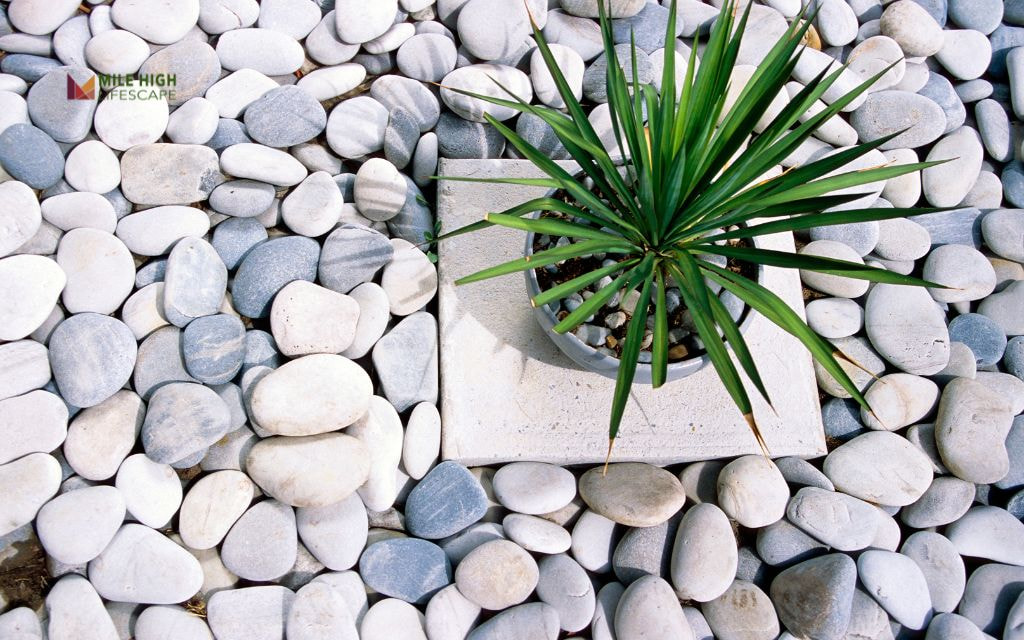
Types of Landscape Rock Available in Denver
Denver landscapes benefit from a diverse selection of rock materials, each offering unique characteristics suited for specific applications and design styles.
| Rock Type | Appearance & Color | Best Use | Notes |
| River Rock | Smooth, multi-colored stones | Dry creek beds, pathways, borders | Popular for water features |
| Pea Gravel | Small, round stones | Walkways, patios, drainage areas | Easy to install, child-friendly |
| Crushed Granite | Angular, gray or tan | Driveways, paths, weed barriers | Good compaction properties |
| Lava Rock | Porous, red/black volcanic rock | Mulch alternative, accent areas | Lightweight and striking |
| Colorado Cobble | Rounded, native tones | Naturalized landscapes, edging | Regionally sourced and eco-friendly |
| Flagstone Chips | Flat fragments | Ground cover or modern design | Often used with pavers |
How To Choose The Right Rocks For Your Landscape
Not all rocks perform equally – your selection should align with both functional requirements and aesthetic goals. Our expertise guides Denver homeowners through these choices:
For Drainage and Erosion Control
Crushed granite, pea gravel, or river rock prove essential for managing water flow. These materials allow water filtration while stabilizing soil on slopes and preventing runoff damage. Install these in swales, French drains, sloped beds, or downspout basins.
For Xeriscaping and Drought-Tolerant Designs
Colorado cobble, lava rock, or crushed granite deliver low-maintenance, water-wise solutions perfectly matched to Denver’s climate. These materials excel in front yard conversions, park strips, and rock gardens where water conservation matters.
For Decorative Borders and Modern Design
Flagstone chips, black lava rock, or colored gravel create visual impact through contrast, texture, and color definition. These materials define contemporary yards, flower bed edges, and patio accents with clean lines and structural clarity.
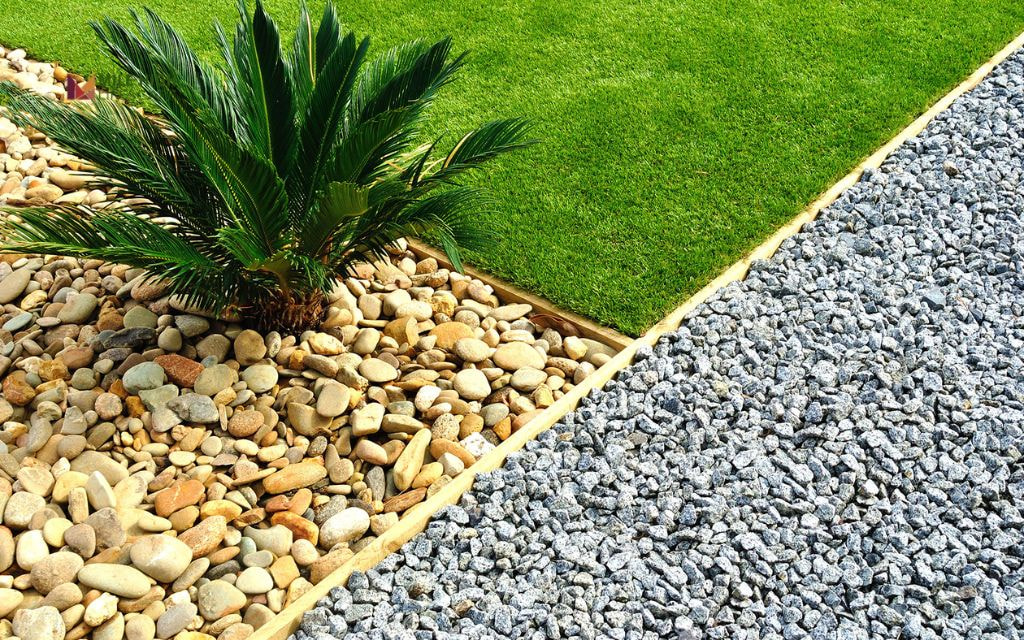
For Paths, Patios, and Play Areas
Pea gravel or crushed stone fines provide comfortable, practical surfaces for high-traffic zones. These materials work well for DIY walkways, fire pit surrounds, and play areas where safety and usability matter.
For Mulch Replacement Around Plants
Shredded gravel or small river rock serves as a long-lasting alternative to organic mulch. These materials protect root systems without attracting pests or developing mold, making them ideal for tree rings, shrub beds, and dry shade zones.
Landscape Rock Costs in Denver: What to Expect
Understanding landscape rock pricing helps Denver homeowners budget effectively. These price ranges represent current market averages for the Denver metro area:
| Rock Type | Price per Ton (avg.) | Delivery Fee | Notes |
| River Rock | $100–$150 | $50–$100 | Higher cost reflects weight and transport challenges |
| Pea Gravel | $60–$100 | $40–$80 | Economical choice with versatile applications |
| Crushed Granite | $70–$110 | $50–$100 | Value price point for a structural base material |
| Lava Rock | $150–$200 | $60–$120 | Premium pricing due to volcanic origin; sold by volume |
| Flagstone Chips | $100–$160 | $60–$100 | Mid-range decorative option with distinctive character |
Cost estimates for landscape rock in Denver depend largely on the rock type, quantity, and additional services such as delivery and installation. Factors such as property size, terrain slope, and accessibility also play a significant role.
Whether you opt for a DIY project or professional installation, budgeting accurately will ensure a successful transformation of your outdoor space.
Contact Mile High Lifescape to receive a free quote and discover our competitive pricing options.
Our Landscape Rock Delivery & Installation Service
Mile High Lifescape delivers comprehensive landscape rock solutions throughout the Denver metro area. Our full-service approach ensures your project proceeds smoothly from concept to completion.
Professional Consultation and Design
Before any rocks arrive at your property, our process begins with thorough consultation. We assess your space, discuss your goals, and develop a plan that aligns with both your vision and practical landscape needs.
Our experts evaluate soil conditions, drainage patterns, and existing features to recommend the optimal rock materials and placement strategies.
Precise Material Selection
Choosing the right landscape rock involves more than aesthetics. We consider:
- Your property’s specific drainage requirements
- Colorado’s climate impact on different rock types
- Color compatibility with existing landscape elements
- Functional needs for traffic areas, borders, or water features
- Long-term maintenance considerations
Accurate Quantity Calculations
We prevent costly overages and frustrating shortages through precise material measurements. Our team calculates exact tonnage requirements based on:
- Square footage of coverage area
- Optimal depth for your specific application
- Density variations between rock types
- Allowance for natural settling and displacement
Efficient Delivery Systems
Our specialized delivery equipment minimizes property disruption while ensuring materials reach exact installation locations. We coordinate timing to align with your schedule and project sequencing, using proper access techniques that protect existing landscaping, driveways, and structures.
Thorough Site Preparation
Proper preparation forms the foundation of lasting landscape rock installations. Our process includes:
- Complete removal of existing vegetation and debris
- Precise grading to establish proper drainage patterns
- Soil compaction to prevent future settling
- Installation of commercial-grade weed barrier materials
- Edging installation to maintain clean material boundaries
Expert Installation Techniques
Our skilled teams apply proven installation methods that ensure both functionality and visual appeal. We focus on:
- Strategic rock placement for natural appearance
- Proper depth management across the installation area
- Attention to drainage patterns and water flow
- Integration with existing landscape features
- Clean transitions between different materials
Final Inspection and Cleanup
We complete each project with meticulous attention to detail:
- Thorough debris removal and site cleanup
- Final grading and material distribution adjustments
- Verification of drainage functionality
- Removal of all equipment and excess materials
- Client walkthrough and approval confirmation
Our team’s specialized knowledge of Denver’s landscape challenges translates into installations that perform reliably while enhancing your property’s visual appeal.
From initial consultation through final inspection, we maintain clear communication and professional standards at every project stage.
Why You Choose Trust Mile High Lifescape
Mile High Lifescape is a Denver-based landscaping expert dedicated to delivering quality craftsmanship, innovative design, and exceptional customer service. Our deep understanding of local conditions and commitment to eco-conscious solutions makes us the ideal partner for your landscape rock needs.
- Locally owned and operated with years of Denver-specific experience
- Experts in xeriscaping and native plant pairings
- Competitive pricing with no hidden fees
- Seamless coordination of materials, delivery, and labor
- One point of contact from concept to completion
Our reputation is built on trust and reliability, with countless satisfied customers throughout the Denver area. We are passionate about transforming outdoor spaces while ensuring the highest standards of professionalism and quality.
Discover the Mile High Lifescape’s landscaping services – contact us today for a consultation!
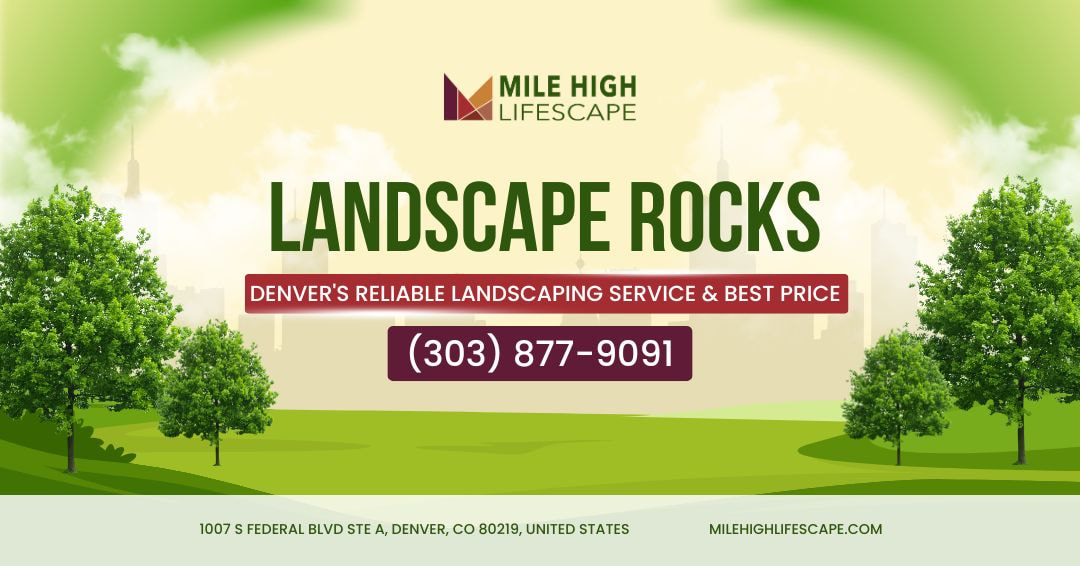
Projects by Mile High Lifescape: Real Results
Project 1: Front Yard Xeriscape in Highlands
Challenge: Replace a water-thirsty lawn with low-maintenance, sustainable materials.
Solution: Installation of flagstone pathways paired with Colorado cobble and native plantings to create an engaging, water-wise landscape.
Result: Water use reduced by 70%, with an aesthetically pleasing design that earned HOA approval.
“Mile High Lifescape transformed our thirsty, high-maintenance lawn into a stunning xeriscape that our neighbors constantly complimented. The flagstone pathways and Colorado cobble created visual interest while solving our irrigation problems completely. Our water bill dropped dramatically, and we haven’t had to mow once since installation. Their team understood exactly what our HOA required and delivered a design that won immediate approval.” – Danielle U, Highlands Homeowner
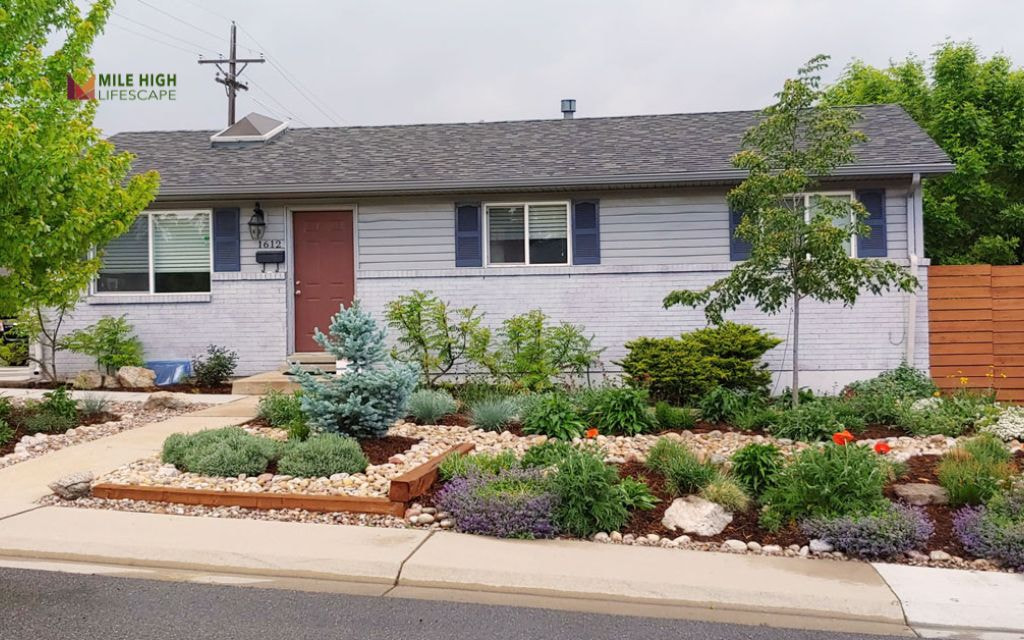
Project 2: Erosion Control in Wash Park Sloped Backyard
Challenge: A sloped backyard prone to erosion and water runoff during storms.
Solution: Implementation of a crushed granite base combined with river rock channels and boulder edging to stabilize the slope and control runoff.
Result: Improved drainage and a polished visual flow that enhanced both functionality and curb appeal.
“After years of watching our backyard wash away with every storm, Mile High Lifescape created a permanent solution that’s both functional and beautiful. The combination of crushed granite and river rock channels directs water exactly where it needs to go, and the boulder placement adds visual interest while stabilizing the entire slope. We endured several major downpours this summer without a single erosion issue. Their team understood the engineering aspects of water flow perfectly while still creating a landscape we enjoy looking at.” – Brian O, Wash Park Resident
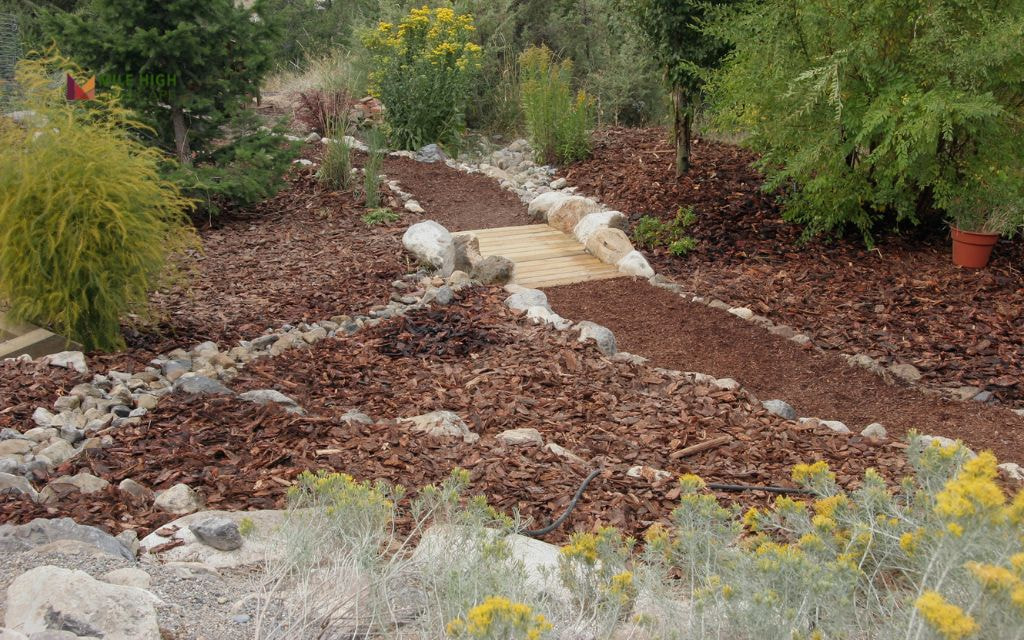
Conclusion
The strategic use of landscape rock creates sustainable, attractive outdoor spaces perfectly suited to Denver’s unique environment. From water conservation and maintenance reduction to enhanced visual appeal and property value, quality landscape rock delivers lasting benefits for homeowners throughout the metro area.
Mile High Lifescape brings nearly two decades of Denver-specific landscaping expertise to your project. Our comprehensive approach – from material selection and delivery to professional installation and integration – ensures your landscape rock investment enhances your property for years to come.
Contact Mile High Lifescape at (303) 877-9091 to schedule a consultation. Our team will assess your property’s specific needs and create a customized landscape rock solution that balances functionality with beauty.
Frequently Asked Questions (FAQs)
How much landscape rock do I need for my project?
For a 2-inch depth, calculate one ton of rock per 160 square feet on average. Coverage varies by rock type – lava rock covers more area per ton than dense materials like river rock. We provide precise calculations during consultation.
Can I install landscape rock over existing grass or mulch?
For proper installation, remove existing materials first. Installing directly over grass or mulch creates drainage problems and unwanted organic material decomposition. Professional preparation includes vegetation removal, soil compaction, and weed barrier installation.
What landscape rock works best for low-maintenance Denver yards?
Crushed granite and river rock deliver exceptional durability with minimal maintenance requirements. These materials resist displacement, maintain color stability, and require no watering or seasonal replacement – ideal for busy Denver homeowners.
How does landscape rock perform during Denver winters?
Quality landscape rock withstands Denver’s freeze-thaw cycles without degradation. Materials like granite and river rock maintain structural integrity through temperature extremes and snow removal activities, making them superior to organic mulches.
Do you offer same-week delivery for landscape rock?
Yes, we maintain inventory of common materials for prompt delivery. Custom or specialty rock may require additional lead time. Contact us for current availability and scheduling options based on your specific project requirements.